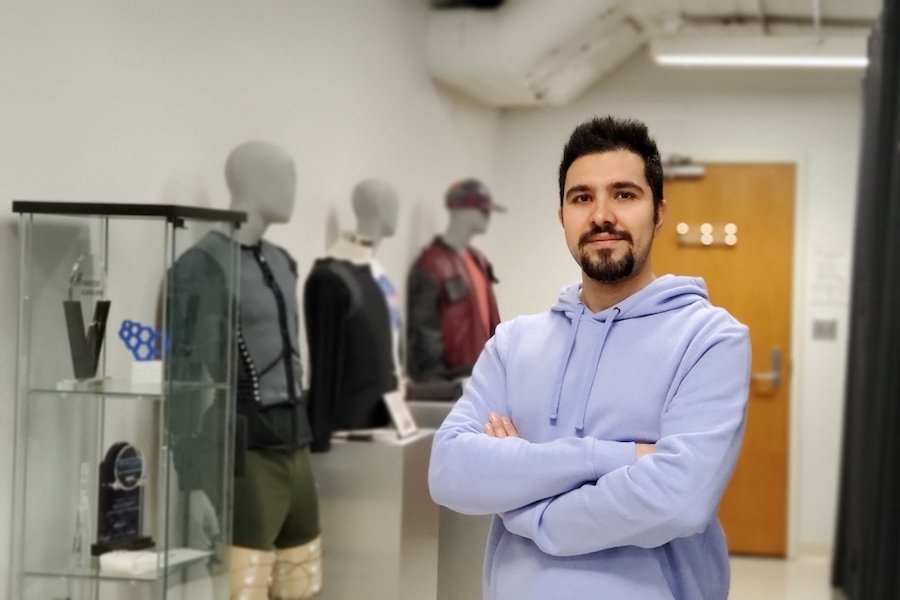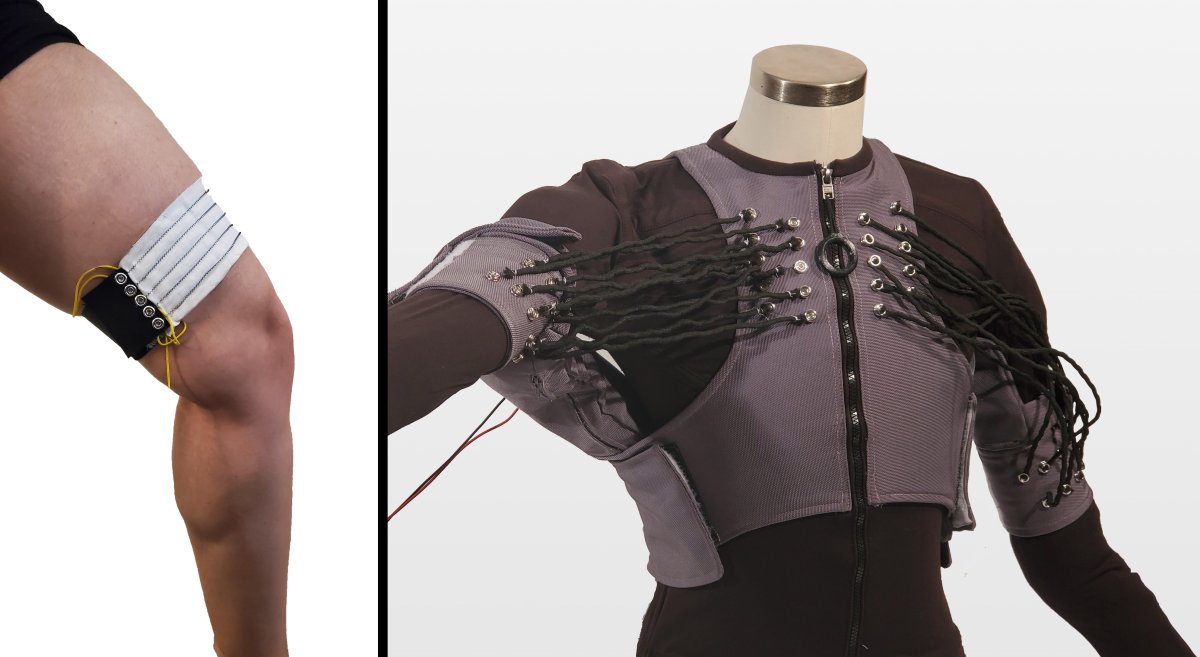For CSE grad student, soft robotics plus smart fabric equals huge potential

Wearable devices make an impact on everyone from medical patients to astronauts
January 14, 2022
Upon hearing the word “tourniquet,” most people think of the device you tie around someone’s injured limb to slow bleeding—like the ones used by action heroes or doctors in films. But “tourniquet” can also refer to a compression garment, like the sleeves that athletes wear to apply pressure to their knee or arm. The latter, non-movie tourniquets are the kind that Alireza Golgouneh works on.
The College of Science and Engineering grad student is pursuing a Ph.D. in electrical engineering, but in his research position in the College of Design’s (CDes) Wearable Technology Lab on the University of Minnesota Twin Cities campus, he works with folks from all majors—from mechanical engineering to apparel design.
Because typical compression garments on the market today are made out of elastic and thread, they get stretched out over time and can’t apply tight compression anymore. The controllable tourniquets designed in the Wearable Tech Lab, however, are made using Shape Memory Alloys (SMAs). These smart materials can change shape when heat or electricity is applied, then return back to their initial shape.
One of Golgouneh’s goals is to use SMAs to make compression materials fine-tunable. In other words, he uses soft, pliable electronics to control the amount of pressure the devices apply to a person’s body—and to change that pressure according to the patient’s need. SMA-based “tourniquets” or compression sleeves could be used to treat diseases such as venous insufficiency (a condition in which the leg veins don’t circulate blood properly) and various athletic injuries.

His lab’s recently published paper, titled “Developing a Smart Controllable Shape Memory Alloy (SMA) based Tourniquet," was awarded second place in the Best Student Hardware Competition at the 2021 American Society of Mechanical Engineers’ Smart Materials, Adaptive Structures, and Intelligent Systems (SMASIS) conference.
“Compression devices can be very practical for many different applications,” Golgouneh explained. “With medical therapy, for example, if your doctor tells you to apply ‘x’ amount of pressure for treatment for your disease, you can do that yourself without a visit to the hospital.”
Interdisciplinary lab is a perfect fit
Golgouneh has always been interested in robotics, but after getting his bachelor’s in mechanical engineering and master’s in mechatronics engineering in Tehran, Iran, he became more interested in the medical devices field and the physiological applications of electrical engineering. So, he decided to pursue a Ph.D. He chose the University of Minnesota in 2018 because he was excited by the Wearable Technology Lab and its interdisciplinary work.
The lab is led by CDes Professor Lucy Dunne and Associate Professor Brad Holschuh, but Golgouneh still works closely with advisors in his home Department of Electrical and Computer Engineering (ECE).
“One of the best things about studying here at the U of M is that faculty members in ECE are so passionate about and open to interdisciplinary projects and research,” he said.
“And the interesting thing about the Wearable Tech Lab is that it brings together so many different majors to make a functional garment. Of course, the classic knowledge of science is important, but nowadays we cannot build a system with just one person—we have to combine our knowledge.”
In addition to the tourniquet, Golgouneh recently played a role in designing a wearable upper-limb “exoskeleton,” a project that recently won him the Best Functional Paper award at the 2021 ECE Science for International Symposium on Wearable Computers (ISWC) conference. The “exoskeleton” looks like a tight long-sleeve shirt that can assist people with upper mobility impairments in moving their arms and shoulders. Unlike the most current assistive and sensing technologies that are bulky and uncomfortable, this wearable exoskeleton utilizes low-profile sensing and hybrid actuating technologies that look and feel like everyday clothing.
“I’ve always liked working in the medical devices industry, because I enjoy helping people and making their lives better,” Golgouneh said.
“That’s one of my personal goals, trying to make medical devices like this exoskeleton that help people in performing their daily activities.”
Creating smart garments for the medical field is just half of Golgouneh’s research. The other part has applications in the aerospace industry—building mechanical counterpressure suits, or MCPs, that astronauts wear to simulate the atmospheric conditions of Earth and assist the astronaut’s cardiovascular system in circulating blood while they are in outer space.
Whether he pursues these applications in the aerospace field or continues with medical devices, Golgouneh sees himself staying in research for a while, possibly doing postdoctoral research in soft robotics at Harvard University or the Massachusetts Institute of Technology.
“These kinds of smart, wearable devices are becoming very popular nowadays,” he said. “They have various applications in many fields, so I’d like to apply my skills and what I’ve learned here at the University of Minnesota to working in this field.”
Story by Olivia Hultgren
If you’d like to support students in the University of Minnesota College of Science and Engineering, visit our CSE Giving website.
